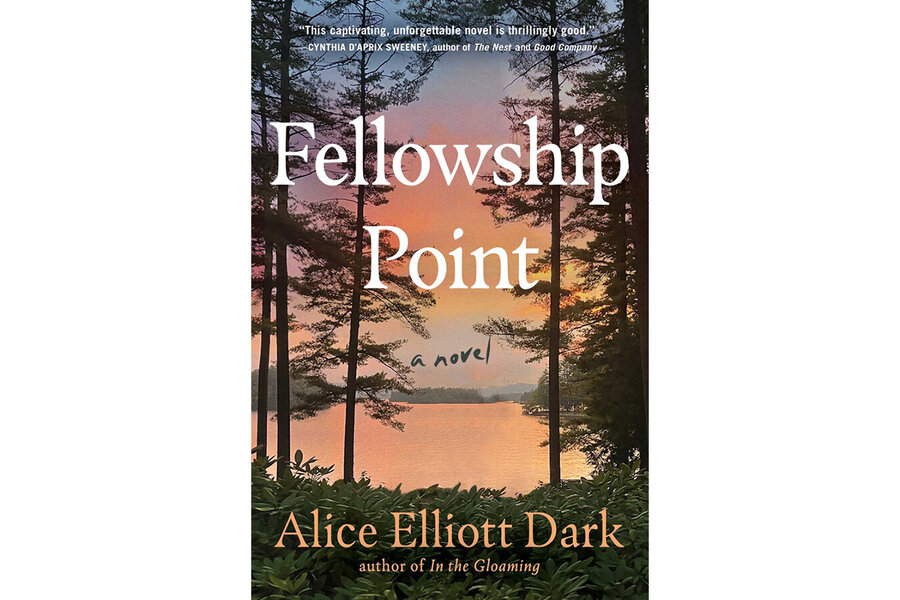Friendship tested, lives transformed in sublime novel ‘Fellowship Point’
Maine, long attractive to writers for its rocky coastlines, woodlands, and wildlife, lends itself to stories about tensions between locals and summer people, and between developers and conservationists. In her exquisitely written, utterly engrossing new novel, “Fellowship Point,” Alice Elliott Dark explores these strains while celebrating Maine’s gorgeous but threatened landscape. At the same time, she celebrates the beauty – and sticking points – of a lifelong friendship between two women whose choices have taken them down different paths.
It is hard to write about this novel without gushing. You sink into it with a sigh of contentment, as into a hot bath. Its characters, settings, and deftly woven plot pull you right in, the better to soak in its reflections on aging, writing, stewardship, legacies, independence, and responsibility. At its heart, “Fellowship Point” is about caring for the places and people we love.
Dark is best known for her twice-filmed, prizewinning story, “In the Gloaming.” First published in The New Yorker in 1993, it is about a mother who, in losing a son to AIDS, rediscovers what it means to really love and be loved. Dark, who teaches creative writing at Rutgers-Newark, has been working on “Fellowship Point” for nearly 20 years. It shows. There is nothing half-baked about it.
Why We Wrote This
Alice Elliott Dark’s magnificent novel affirms that change and growth are possible at any age. As her main characters let down their guard and shed old habits, they experience transformation.
At the novel’s center is 80-year-old Agnes Lee, a writer who has never married. She is beloved for her “When Nan” series of children’s books about a plucky 9-year-old girl’s adventures, beginning with “When Nan Was a Lobsterman” in 1965 to the most recent installment, “When Nan Ran a Wind Farm.” But what Agnes considers her real work are her six “Franklin Square” novels, published one per decade under a pseudonym, which enabled her to write undercover about women from her tony Philadelphia social set. To her dismay, these women, like her best friend Polly Wister, made “themselves smaller in order to fit into the roles available to them. Their talents were subsumed into utility and support.” Agnes intended her books as “cautionary tales ... that real women would learn from.”
We meet Agnes in 2000, struggling to write one last Franklin Square novel. She is less concerned about her recent cancer diagnosis than the future of Fellowship Point, the coastal peninsula in Maine where she has summered her whole life and felt most free and happy. In 1872, her great-grandfather, William Lee, a Philadelphia Quaker from a rich merchant family, bought 145 acres on Maine’s fictional Cape Deel and established the Fellowship Point Association with his brother and three Quaker friends. Its rules state that its five members would own shares in the association rather than individual plots of land. Further, shares tied to the five “capacious, yet not absurd” family cottages William designed were to be passed down to only one blood-relative member in each succeeding generation. Agnes and Polly are the current shareholders of their family’s cottages, Leeward and Meadowlee.
William and his descendants have particularly treasured a 35-acre wildlife sanctuary at the property’s tip, dubbed the Sank. But to Agnes’ dismay, this hallowed land, formerly Abenaki territory, is threatened with desecration by a local developer who hopes to build a resort and village on Fellowship Point by luring shareholders with the promise of an economic windfall. Agnes’ counter-plan, which changes somewhat over the course of the novel, is to muster the required majority of shareholders – three votes – to dissolve the association and establish a trust to protect the land. She is counting on her friend Polly to support this move, but, frustratingly, Polly doesn’t do anything without consulting the men in her life.
Dark sets up a tug of war between Agnes’ strident independence and Polly’s deference to her self-important husband and money-hungry eldest son, who belittle her at every turn. Several contingent plotlines add intrigue, including the unfortunate ordeal of a smart local landscaper who is falsely accused of theft by Agnes’ ostentatious cousin Archie Lee, a shareholder eager to capitalize on his holdings. The other two original families no longer come to Fellowship Point, and we eventually learn what happened to one of them 40 years earlier. Dark cleverly uses Agnes’ intimate notebooks written at the time to pull off this long flashback.
“Fellowship Point” has the complexity, pace, and length of an absorbing 19th century epic. Another narrative strand involves an ambitious New York editorial assistant named Maud Silver, who hopes she can jumpstart her publishing career by convincing Agnes to write a memoir callled “Agnes When,” about how she came to write the “When Nan” books, now celebrated for their proto-feminism. Agnes, with big secrets to hide, pushes back, but can’t help being impressed by Maud’s mettle – especially when she learns that the young woman, a single mother, is further saddled with the guardianship of her intractably depressed mother.
The novel’s various plotlines dovetail with amazing grace, culminating in a moving, well-earned climax. “Fellowship Point” is, on one level, the story of how Agnes gradually lets down her guard and opens up, beginning with her uncharacteristic decision to share her notebooks from the early 1960s, a turning point in her life. “It’s awful what we do to ourselves by not talking openly,” she comments. Polly, too, blossoms with her recognition of how the “habit of a lifetime of acquiescence” had prevented her from recognizing her own intelligence. This magnificent novel affirms that change and growth are possible at any age.
Heller McAlpin reviews books regularly for The Monitor, The Wall Street Journal, and NPR.






